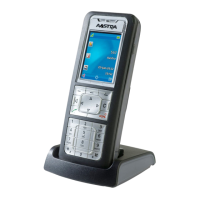Expansion Stages and System Capacity
51
Aastra 415/430 as of R3.2
syd-0344/1.6 – R3.2 – 09.2014
The length varies depending on the type of interface card. For precise dimensions
see the Chapter "Technical data", page 247.
Fig. 9 Design of the interface cards
3. 3. 2. 1 Trunk cards
The trunk cards contain interfaces for connection to the analogue public network
(PSTN), the digital public network (ISDN) or for networking systems to create a pri-
vate telephony network (PISN). The trunk cards can be used and operated on any
slots for interface cards.
Some trunk cards contain both network interfaces (BRI-T) and terminal interfaces
(BRI-S). On these cards the ratio of BRI-S interfaces to BRI-T interfaces is determined
by the use and plug-in orientation of the Wiring Adapters (see "Wiring Adapter",
page 98).
Note
On the ESST terminal card the jumper must always be fitted in position T
(see Fig. 24).
Tab. 24 Trunk cards
Type
Network interfaces
per card
Max. number
of Aastra 415
cards
Max. number
of Aastra 430
cards
Remarks
TIC-1PRI 1 PRI 2 2 • Contains 30 B channels
• 10 B channels can be used licence-
free
TIC-4TS 3 BRI-S/T + 1 BRI-T 2 4 • Three BRI-T interfaces configurable
to BRI-S
• One fixed BRI-T interface
TIC-2TS 2 BRI-S/T 2 4 • Both BRI-T interfaces configurable
to BRI-S
ESST
1)2)
1 BRI-S/T + 1 BRI-S 2 4 • One BRI-T interface configurable to
BRI-S, one fixed BRI-S interface
• The jumper on this card must
always be fitted to position T.

